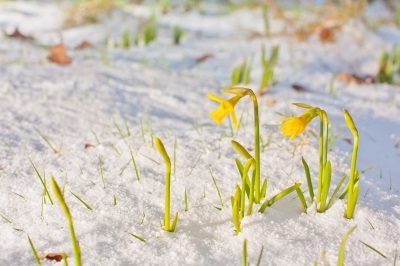|
Spring Lawn Care Checklist:
Take It Easy on the Soil Don't be in a hurry to start working in your yard. Let the soil thaw and dry out before beginning your spring lawn care chores. Foot traffic on wet soils will cause soil compaction problems. Even worse damage is caused by walking on lawns where the soil has thawed on top and is still frozen underneath, shearing roots in the frozen soil from the grass plants on top. If you get too aggressive with raking, mowing or aerating - any activity that will open up the turf grass canopy exposing it to sunlight - you risk damaging fragile new growth and giving early germinating weeds the jump on your lawn grass. Wait until your grass is actively growing. Sharpen Your Lawn Mower Blades Early spring is a good time to give your lawnmower and other power tools a tune up. Sharpen your lawn mower blades, change the oil, spark plug, and filters. Mow Low to Remove the Dead Tops Once your lawn starts to green up, give it a good short cut to remove the dead grass tops. This will give the newly emerging leaves the sunlight they need and get them growing. Take care not to cut it too short - scalping and damaging the crowns of the plants. If you are a 'grass cycler' it's OK to collect the clippings and excess debris this first mow of the year. Core Aeration Aerating benefits your lawn in several ways: reduces soil compaction, controls thatch, stimulates new root growth and improves water, air and nutrient filtration. Fall is the best time to aerate cool-season grasses and warm-season grasses should be aerated in the summer - when they are actively growing. If you missed out on aerating your cool-season lawn last fall, spring is the second-best time to get this done. Just be sure you aerate before you apply a crabgrass preventer. A good time to top dress with compost is right after you aerate, all soils benefit from adding organic matter. Thatch Control - Aerating will help control thatch and is less damaging to grass plants than power raking. If your thatch layer is over 1/2" deep, you'll want to consider dethatching with a power rake. Again, wait to power rake until your grass is actively growing and wait to apply crabgrass preventer until after you rake. Overseed Bare Areas Fall is the best time to seed cool-season grasses. However, there is a short 'window of opportunity' you can take advantage of in the spring... Grass seed will start to germinate when soil temperatures reach 50° F. Get your seeding done early enough so the new grass plants have time to develop strong roots before the summer stress period. Over seeding works best when combined with aerating. Seeds will find their way into the aeration holes where they are protected, make good contact with the soil, and germinate quickly. Skip the crabgrass control if you Overseed because it also works on grass seed. Plant warm-season grasses after the danger of frost has passed - late spring into early summer. Crabgrass Control Crabgrass prevention is a very important spring lawn care chore. Spring is the time to prevent crabgrass. If your lawn is dense and vigorous, consider taking chemical weed controls off your spring lawn care list. A dense and vigorous lawn will not allow weeds to invade...its the best weed control. Crabgrass is a prolific seeder. If you had crabgrass last year, expect to see it again this year and consider using a pre-emergence herbicide. These crabgrass preventers stop weed seeds from germinating, so you will want to apply them before seeds germinate to get the best control. This will be when soil temperatures reach 50° F. Many gardeners plan to apply their pre-emergence around Easter. Blooming forsythia is another good indicator - when you see the yellow blooms, the soil temperature is 50° F. Don't worry if you are late applying pre-emergence - crabgrass and other weed seeds are germinating all season long and you'll still get some control...better late than never. Pre-emergence herbicides will control a broad spectrum of weeds along with crabgrass and many products will give you three to six months’ control. When Should You Fertilize and How Much? Go easy on the fertilizer in the spring. Too much will cause a flush of growth at the expense of the roots. Cool-season grasses - including Kentucky bluegrass, fescues and ryegrass - should receive the majority of their annual fertilizer in the fall, that's when they will benefit the most. Lawns that were fertilized in the fall will green up early and won't need to be fertilized until late spring. A light spring application - around Memorial Day - will keep them healthy and give them a nice green color boost. The amount of fertilizer that you apply in late spring should be less than 1/2 lb. Nitrogen/1000 ft2. If you missed your fall fertilizer, make it up with a couple light applications. Wait until the grass is actively growing (around mid-April) and then apply 1/4 to 1/2 lb. nitrogen/1000ft2. Make another light application six weeks later (Memorial Day). Warm-season grasses benefit from summer fertilizer applications, that is when they are actively growing. Wait to fertilize Bermudagrass, zoysia, St. Augustine, and other warm-season grasses until they green up. At least 75% of the lawn should be green. Fertilizing too early in the spring can cause a flush of growth that can damage the plants if there is a late heavy frost. Wait to Water The last item on your spring lawn care list should be watering. It's tempting to start watering in early spring, but there is usually plenty of rain to keep your lawn healthy. Wait to water until the weather gets warm and dry. It's ok to let the grass show signs of drought stress - this will actually cause to roots to grow deep searching for water. Waiting until the weather turns hot and dry encourages deep rooting and that will prepare your lawn for the dog days of summer. Trinuck Properties Inc. Residential Home Inspections Trust Trinuck Proudly serving Edmonton and surrounding areas www.trinuckproperties.com 780-499-2739 trinuck@gmail.com Check the A/C
Have a qualified HVAC contractor? Give your air-conditioning system a tune-up. To help lower your energy bills, do this every year to ensure the system is running at its manufacturer-rated efficiency. Also make sure to inspect your system's condensate drain hose, especially if you live in a humid climate. This hose could become clogged with algae and sediment, and your contractor may charge you more to clean it out. Avoid this extra cost by checking the hose periodically yourself. Use a wet-vac to suction any blockage out from it. Check the Roof and Gutters The hot summer sun can quickly damage a roof's shingles, so you may want to call a contractor if you haven't inspected your roof in several years. Clean out the leaves and other debris that have collected in them. Then check to see if the gutters are safely attached and haven't sprung any leaks. Also, make sure that downspouts direct water away from the house's foundation, to prevent a potential basement flood. Check the Foundation For further basement flood protection, inspect the foundation around your house before the spring rains. Look for cracks or imperfections, and seal them or call a contractor if necessary. Also look for low areas in the yard near the foundation that might pool water during a heavy rain. Level these yard depressions by filling them with compacted soil. Tend to any other "ponding" areas around the yard, too, because after a hard rain, standing water can develop. These puddles can be a breeding ground for mosquitoes. Maintain Your Deck If you have a patio deck, inspect the wood for stains, discolorations, or warping. If you find any, consider resealing the deck. To verify that your old application still works, pour some water onto the dry deck and check to see that it beads up. Most deck-sealer manufacturers recommend resealing annually, but if there are no immediate problems worth addressing, you can likely wait until the following spring to reseal. Check for any sharp edges, splintered wood, or rotting wood. Also look for rusting nails or any nails that are coming out or weakening their connections. And be sure to check the railings and stairs to make sure they are secure and not wobbly. Garden Spring is the season to prepare for new growth in your garden. Rake beds of leaves and other leftover winter debris. Use a hoe to churn and loosen the soil, and mix in compost for nutrients. If you’ll be planting new seeds, follow the instructions provided on the seed packet for the best results. Inside the House The Water Heater Look around the base of your water heater for evidence of leaks. The average lifespan of a water heater is 8-12 years. If your water heater is over 5 years old, it should be checked monthly for any leakage or rusting at the bottom. If water leakage or rust is found, the water heater should be replaced. If you live in an area with particularly hard water, you may need to drain your water heater because of the sediment buildup in the tank. Recommend to do this every 6-9 months. The Basement and Attic Does your attic or basement smell musty? If you have an attic, check it for leaks from the roof. Inspect the underside of the roof and the insulation closely for any discoloration, deterioration or dirt stains, as the leaking water might have dried up. Check the basement walls, floor, and trim for water stains or any signs of seepage through the foundation. There are a number of flooding causes. While you're down there, keep a close eye on your sump pump, making sure it is still in good working order, and has a battery backup in place if necessary Prevention Tips:
Thank you. Darren Gafiuk Trinuck Properties Inc. www.trinuckproperties.com 780-499-2739 TRUST TRINUCK This is a checklist you can use and incorporate into your regular maintenance schedule for your home.
Check for damage to your roof, eaves and downspouts, check all fascia and trim for damage. Have an HVAC professional inspect and maintain your system as recommended by the manufacturer. Check your water heater for leaks and rust also drain a bucket full of water out of your hot water tank. Check all your fire extinguishers and also your smoke detectors replace if they are 7 years old. Clean the kitchen exhaust hood and filter. Consider repairing all cracked, broken and uneven driveways and sidewalks to provide a safe walking surface. Check the shutoff valves at all plumbing fixtures to make sure they are functioning. Clean the clothes dryer exhaust duct and damper, and also the space under the dryer. Compliments Trinuck Properties Inc. Certified Professional Home Inspector proudly serving Edmonton and surrounding areas. Certified Ozone Shock Technician as well, which is the removal of unwanted odors within a home, the process is chemical free and very safe. The most common odors we deal with are cigarette smoke, food odors and musty smelling basements. Thank you. Darren Gafiuk Trinuck Properties Inc. www.trinuckproperties.com 780-499-2739 TRUST TRINUCK |
AuthorDarren Gafiuk Archives
December 2018
Categories
All
|
Open 7 Days a WeekNo Additional Fee for evening or weekend appointments.
Phone: 1-780-499-2739
|
Services |
Member of:Our GuaranteeProud Supporter of: |
© COPYRIGHT 2022. ALL RIGHTS RESERVED.





 RSS Feed
RSS Feed






